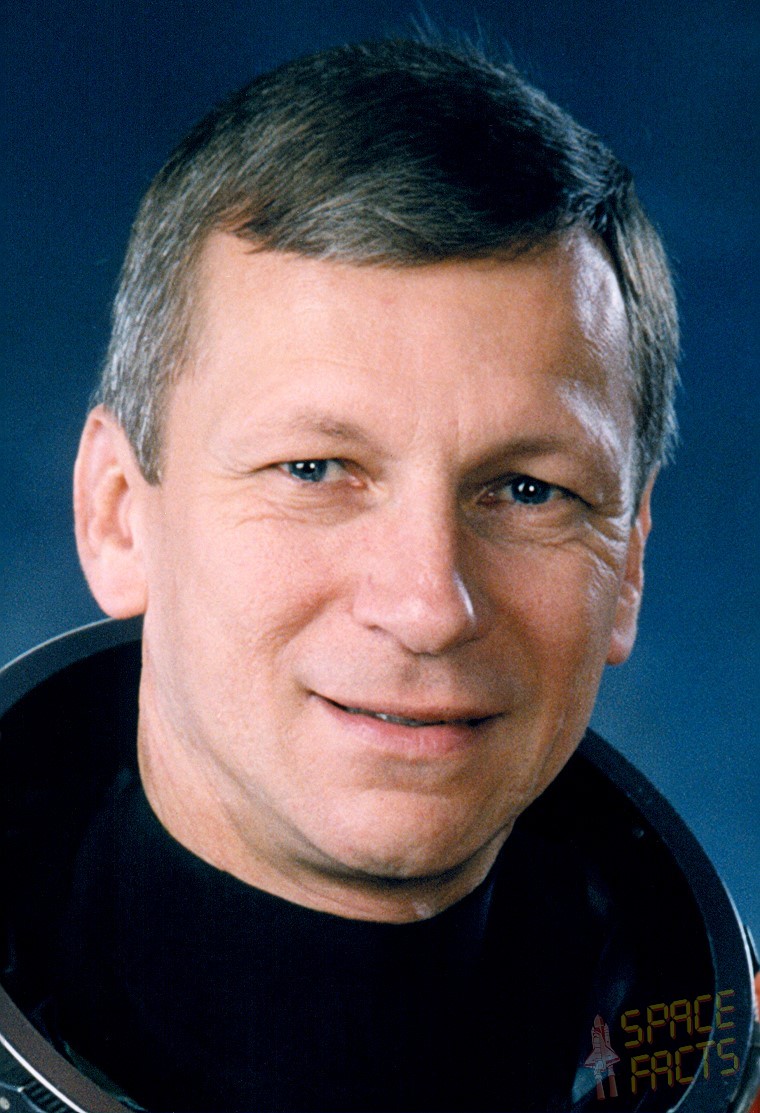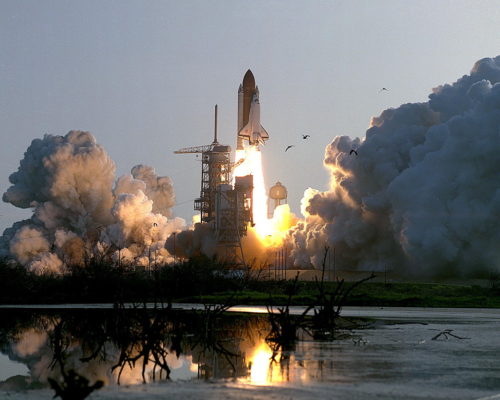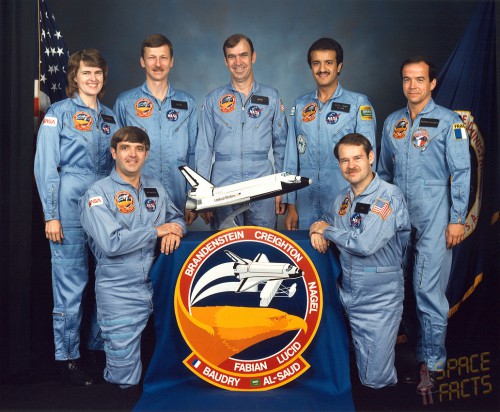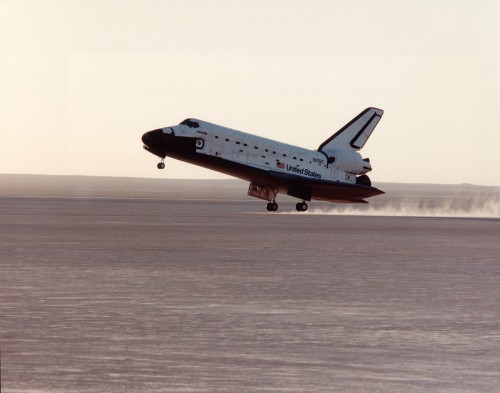
Veteran shuttle astronaut Steve Nagel died Thursday, 21 August, following a lengthy battle with cancer. He was 67. His passing was reported by the Association of Space Explorers (ASE) and drew numerous tributes, including former astronaut Tom Jones, who wrote that he was “an exemplary role model for astronauts and space professionals” and added that Nagel was “a terrific family man.” He leaves behind his wife, fellow astronaut Linda Godwin—with whom he flew in space on STS-37 in April 1991—and two daughters. Nagel’s life was a story of triumph over adversity, but aviation was his lifeblood: from his first solo flight on his 16th birthday to being placed on the alternate list for the Air Force Academy, from flying jets in Thailand to instructing the astronauts destined to fly shuttle Enterprise on its Approach and Landing Tests (ALT), and from one of the last members of his astronaut class to draw a flight assignment to a dazzling, four-mission career. He is also the third member of the 61A shuttle crew to have died in 2014, following Wubbo Ockels in May and Hank Hartsfield in July.
Nagel’s first flight into space began on 17 June 1985, when he boarded the flight deck of Shuttle Discovery for Mission 51G, behind Commander Dan Brandenstein and Pilot John Creighton. As he was being strapped into his seat, Nagel took some advice from fellow crewman John Fabian. “Nagel,” said Fabian, “you’re in for one hell of a ride!” It would be a spectacular ride, but in a quite different seat to the one Nagel had anticipated when he was selected as a shuttle pilot by NASA in January 1978. Both he and Dave Griggs flew their first missions, not as a pilot, but as a mission specialist, and much was written over the years about why certain astronauts were assigned in this fashion.
For his own part, Nagel never questioned why he did not receive a pilot slot on his first mission, but privately questioned his own abilities. “Nothing against mission specialists,” he told the oral historian. “I’d trade my pilot’s slot to go be a mission specialist and do an EVA.” The most likely rationale seems to be that the 1978 astronaut class was particularly large, and there were many more mission specialist places available than pilots. In order to fly sooner rather than later, NASA management decided to front-load several pilots onto flights as mission specialists. “The other way of looking at it,” recalled John Fabian, “was that they were doing Steve a favor. Better to give him a flight, flying the middle seat as a flight engineer, which would mean that he was learning the procedures necessary to fly the ascent and the entry, rather than to keep him sitting on the ground.”

As the flight engineer for Mission 51G, Nagel trained on the same systems as the pilots and, years later, he admitted that it served him well. If nothing else, he gained mission-specific EVA training out of the assignment. His uncertainty was also calmed by words from George Abbey: NASA would fly him as a pilot soon succession … and he kept his word. In February 1984, Nagel was assigned as pilot of the 51K mission, a joint Spacelab flight with West Germany, then scheduled for September 1985. At this point, Nagel’s first mission, then known as 51A, was expected to fly in October 1984 and that would have meant that his two flights would be about a year apart. “The spacing was nice,” he said. Problems arose when his first flight slipped into the spring—then the summer—of 1985, whilst his second flight didn’t move. As a result, Nagel did fly as a pilot, in quick succession, but far quicker than he could have anticipated. In fact, he would launch on his second flight only four months after landing from his first flight … a personal and empirical record which would stand unchallenged for more than a decade.
Like so many of his contemporaries, Steven Ray Nagel grew up with a love of aviation. He was born in Canton, Ill., on 27 October 1946. His father was not a certified instructor, but owned a small Piper Cub and took his son flying from a very early age—as an infant, in fact—and after taking lessons the young Nagel soloed on his 16th birthday. By this time, the first two groups of NASA astronauts had been selected and, although he aspired to such a career, Nagel spoke little about it, preferring instead to enter the military and fly jets. He applied to the Air Force Academy, but was placed on an alternate list and eventually entered the University of Illinois at Urbana-Champaign, in his home state, to study aeronautical and astronautical engineering. Whilst there, he enrolled in the Reserve Officers Training Corps (ROTC) and, upon graduation in 1969, entered the Air Force.
With the war in Vietnam at its peak, he said, “the people pipeline was wide open, so the classes were big in pilot training.” Nagel completed his flight instruction at Laredo Air Force Base, Texas, then commenced training in the F-100 Super Sabre at Luke Air Force Base, Ariz., and later served in a tactical fighter squadron in Louisiana. By this time, in the late summer of 1971, the war was winding down. Nagel served for a year in Thailand as a T-28 Trojan instructor pilot, then returned to the United States as an instructor and flight examiner for the A-7D Corsair II. The dream of NASA had matured over the years and Nagel wrote to the agency, asking what sorts of aircraft he should fly. “That was a dumb question,” he admitted to the oral historian. “They couldn’t have told me! Nobody answered me anyway.”

The path which would eventually lead to space took him next to Edwards Air Force Base, Calif., and test pilot school. On graduating in December 1975 he remained to conduct test work on the A-7D and the F-4 Phantom II. At one stage during this period, the Approach and Landing Tests (ALT) of Shuttle Enterprise were being conducted at Edwards and Nagel found himself providing A-7D flight instruction to astronauts Joe Engle, Dick Truly, Fred Haise, Gordon Fullerton, and Vance Brand. In a close-knit community of test pilots, Nagel found that when NASA came calling for astronaut applicants, virtually everyone wanted to be considered. As each group came back from interview, they had their own stories: Some thought the process was a piece of cake, whilst others were mortified that the panel asked them about current affairs. Some of the pilots even went out and bought copies of Time magazine to keep themselves updated with world events. Nagel himself was summoned to the Johnson Space Center (JSC) in Houston, Texas, in September 1977, and at the time of his selection in January of the following year he was in the process of completing a master’s degree in mechanical engineering at California State University.
Eight years elapsed before he flew his first mission, 51G aboard Discovery, and in October 1985—just 128 days later—Nagel launched as pilot of the West German Spacelab-D1 mission. This second flight turned out to be the final successful voyage by Challenger and the only space mission to launch and land with as many as eight members. One of them, German astronaut Reinhard Furrer, died in 1995, whilst a further three, including Nagel, have all passed away within months of each other in 2014. Nagel’s record between flights endured for more than a decade and was unbroken until the STS-83/94 reflight in April and July 1997.
In the wake of the Challenger tragedy, Nagel was assigned in April 1989 to command STS-37, an ambitious mission to deploy NASA’s Gamma Ray Observatory (GRO). The flight later expanded to encompass spacewalks to not only free a jammed antenna on the payload, but also to practice Space Station Freedom assembly tasks. After many delays, the mission launched in April 1991. Joining Nagel on STS-37 were Linda Godwin, who would later become his wife, and Jerry Ross, who served as best man at their wedding. “Steve and I had known each other for quite a few years out of Edwards,” recalled Ross in his NASA oral history, “and since he went to the University of Illinois and I went to Purdue, we harassed each other quite often!”

Landing of STS-37 was particularly hairy, due to an incorrect call on high-altitude winds, which caused Nagel to land the shuttle somewhat short of the dry lakebed runway at Edwards Air Force Base. Years later, he blamed himself for the shortfall. “It wasn’t a real great day to land at Edwards,” he told the oral historian. “There were high-altitude winds aloft and a big wind shear.” As he prepared to perform a 270-degree turn to reach the runway, he allowed the orbiter to depart from the turn and “was not really aggressive about correcting back.” He smoothly corrected back and rolled out onto his final approach, a little low, but the presence of the wind shear caused him to lose a lot of airspeed. “If I’d been real aggressive in how I flew,” Nagel continued, “really slowed it down and stretched it a little bit, I could’ve been back on the glide path okay, but I wasn’t that aggressive with it.” Due to the nature of the dry lakebed, he was not even aware of how short he did land. Not much attention was paid to the event in the newspapers, although Aviation Week & Space Technology mentioned it and, certainly, in the astronaut office it was definitely analyzed. Nagel accepted responsibility, but admitted that the wind shear information and its negative effects factored into his decision-making on the day.
It did not harm his career and after STS-37 he worked for a time as deputy chief astronaut, before being reassigned in early 1992 to command STS-55, the second German Spacelab mission … along with his old buddy, Jerry Ross. During the course of STS-37, Nagel had taken a photograph of Ross during his EVA, grinning at his crewmates through the shuttle’s aft flight deck windows. Two years later, in April 1993, as the STS-55 crew prepared for their mission, Nagel arranged for the photograph to be blown up in size to fit inside one of the shuttle’s aft windows. It was then covered, on the inside, by a protective panel for ascent. When STS-55 achieved orbit, one of Ross’ tasks was to remove the window covering … and when he saw his own grinning face staring back at him, he burst out laughing.
STS-55 was Nagel’s fourth and final shuttle mission, bringing his cumulative spaceflight time to 30 days. For a time, there existed a possibility that he may have drawn the command of STS-71, the first shuttle-Mir docking mission, but that assignment eventually went to Robert “Hoot” Gibson, and in February 1995 Nagel retired from the Air Force and departed the astronaut office to serve as deputy director of operations development in JSC’s Safety, Reliability and Quality Assurance Office. A year later, he moved to the Aircraft Operations Division as a research pilot, chief of aviation safety, and deputy division chief. Nagel retired from NASA in May 2011. Later that year, he and his wife, Linda Godwin, joined the University of Missouri; she as a professor of physics and he as a retention specialist in the College of Engineering and an instructor in the Mechanical and Aerospace Engineering Dept. With his passing, Steve Nagel leaves behind his wife and two daughters, to whom the AmericaSpace team extends its sincere condolences.
Want to keep up-to-date with all things space? Be sure to “Like” AmericaSpace on Facebook and follow us on Twitter: @AmericaSpace



